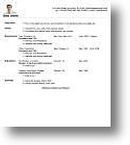- Formatting Your Resume
While following the proper general format and styling is typically beneficial, the overall outcome and job prospects that you may encounter are not necessarily going to benefit from them. The suggestions provided are here correct, but it is truly the content provided by the author that determines the outcome for the applicant. - General Outline for the Format of a Resume
Below is the basic format broken down into sections. Keep in mind that this formatting is generalized and therefore, may not fit your exact needs. Feel free to change or modify each section to fit your profession.- Objective (Use with caution): An objective statement is a brief two to three sentence blurb about your goals, aspirations, and what you want achieve by working at the company. You may not want to use an objective unless your profession specifically uses one, they are becoming less common.
- Career Statement/Summary: This is also optional, and is composed of a few sentences describing the major accomplishments and accolades that you have achieved throughout your career. This isn't recommended unless your resume is sparse in another area, and you want to fill in the page. You can use our Additions section to add this using the Opening Addition for this instead of an Objective.
- Experience Section: The experience section should include all of your related or impressive work experience.
Just be careful to observe the correct formatting template included here:
- Business Name
- City, State
- Dates worked there
- Job title held
- Duties and responsibilities
Continue with this formatting arrangement until you have listed all your relevant work experience. Due to space constraints try not to exceed three jobs, unless they really add value. - Education Section: The education section should list any, and all the formal education and training that you have received that makes you qualified for the job position.
If your education extends beyond a high school diploma, then don't include your high school unless the employer asks for it. Meaning that if you have a college degree, you normally wouldn't include the details about your high school. Along the same line, if you have a degree that goes beyond a two-year or four-year program list that first and only include a minor degree if it is relevant. You should present this section like this:
- University, degree, and date
- Awards and honors
- Continue in this format
- Skills Section: Take the time to outline and evaluate your skills in this section. Include only the skills that pertain to the field in which you are involved.
If you have completed any training sessions or have attained related certificates you may list them here. Your skills section should be presented as such:
Skill - a brief description about how you use that skill at work.
Certificate - when and how you obtained this. - References: You should have a separate reference page, but if you'd like to make that more clear to your reader, you may include the text, "References Available Upon Request" placed at the bottom to alert the employer to that particular page in your portfolio.
You are bound to format your resume correctly by following the guidelines for resume formatting and taking your situation into account. That is a step in the right direction when it comes to the interview process. Start writing yours by clicking the button:
 The resume format is broken down into
The resume format is broken down into